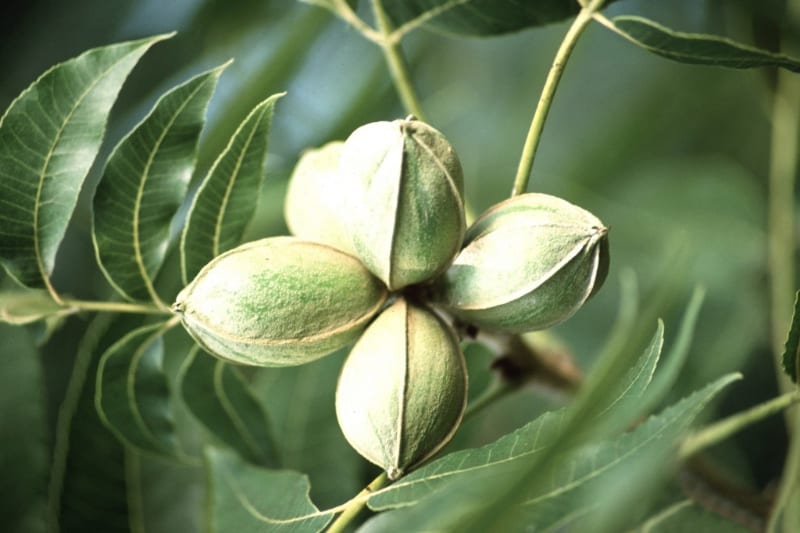Pecan Trees from Our Pecan Tree Nursery
Pecan trees are native to the United States, where they thrive in Southern locations with a long growing season. Just one tree will produce plenty of nuts for a large family and provide deep shade that will make hot, southern summers a little more bearable. Growing pecan trees in small yards isn’t practical because the trees are large and there are no dwarf varieties. A mature pecan tree stands about 150 feet tall with a spreading canopy. If you would like to purchase pecan trees, contact our pecan tree nursery, today! Georgia Pecan Nursery is a retail and wholesale pecan nursery with pecan trees for sale. Learn more about our trees.
Pecan Tree Planting Guide: Location and Preparation
Plant the tree in a location with soil that drains freely to a depth of 5 feet. Growing pecan trees have a long taproot that is susceptible to disease if the soil is soggy. Hilltops are ideal. Space the trees 60 to 80 feet apart and well away from structures and power lines.
Pruning the tree and the roots before planting will encourage strong growth and make pecan tree care much easier. Cut off the top one-third to one-half of the tree and all of the side branches to allow strong roots to develop before they have to support top growth. Don’t allow side branches any lower than 5 feet from the ground. This makes it easier to maintain the lawn or ground cover under the tree and prevents low-hanging branches from becoming obstructions.
Bare root trees that feel dry and brittle should be soaked in a bucket of water for several hours before planting. The taproot of a container grown pecan tree needs special attention before planting. The long taproot usually grows in a circle around the bottom of the pot, and it should be straightened before the tree is planted. If this isn’t possible, cut off the lower part of the taproot. Remove all damaged and broken roots.
How to Plant a Pecan Tree
Plant pecan trees in a hole about three feet deep and 2 feet wide. Position the tree in the hole so that the soil line on the tree is even with the surrounding soil. Adjust the depth of the hole, if necessary.
Begin filling the hole with soil, arranging the roots in a natural position as you go. Do not add soil amendments or fertilizer to the fill dirt. When the hole is half full, fill it with water to remove air pockets and settle the soil. After the water drains through, fill the hole with soil. Press the soil down with your foot and then water deeply. Add more soil if a depression forms after watering.
Caring for Pecan Trees
Regular watering is essential for young newly planted trees. Water weekly in the absence of rain for the first two or three years after planting. Apply the water slowly and deeply, allowing the soil to absorb as much as possible. Stop when the water begins to run off.
For mature trees, soil moisture determines the number, size and fullness of nuts as well as the amount of new growth. Water often enough to keep the soil evenly moist from the time the buds begin to swell until harvest. Cover the root zone with 2 to 4 inches of mulch to slow water evaporation.
In spring of the year after the tree was planted, spread a pound of 5-10-15 fertilizer over a 25 square foot area around the tree, beginning 1 foot from the trunk. The second and third year after planting, use 10-10-10 fertilizer in the same manner in late winter or early spring and again in late spring. When the tree begins to bear nuts, use four pounds of 10-10-10 fertilizer for each inch of trunk diameter.
Zinc is important for pecan tree development and nut production. Use a pound of zinc sulfate each year for young trees and three pounds for nut-bearing trees.
Source: Pecan Planting Guide: Tips On Growing And Caring For Pecan Trees

